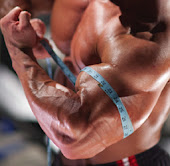Do I Have Big Arms?
So, are 16-inch arms considered big? How about 15-inch or 17-inch arms? Let's unravel the mystery of what qualifies as big arms.
You shouldn't just focus on your biceps or triceps; don't forget the importance of well-defined forearms to complete your arm's overall appearance. It's been suggested that beefing up your forearms by an inch can add significant size to your biceps.
Discover how to achieve this in my comprehensive article, The Key to Building Big Forearms.
For that ideal physique, traditional measurements suggest that the neck, upper arms, and calves should all have the same circumference, typically around 17 inches.
Indeed, a few individuals might effortlessly attain these measurements.
However, achieving this symmetrical perfection can be a considerable challenge, as muscle growth varies across the body.
In this article, we'll delve into what's generally considered "big" when it comes to arms, particularly your biceps and upper arms.
How to Measure Your Arms
For the purpose of this article, upper arm measurements are established on a cold, flexed upper arm using a measuring tape. By "cold," I mean without muscle pump or at least twelve hours after a workout.
The ideal measuring tape for arm measurements, like the MyoTape Body Measure Tape, is non-elastic, delivers consistent outcomes under dry and moist conditions, and remains secure during positioning.
Additionally, body composition plays a role when evaluating arm size. Individuals with higher body fat can yield substantially bigger arms due to the fat tissue volume beneath the skin.
Conversely, a lean, muscular individual might display smaller tape measurements due to their lower body fat percentage. We'll employ the example of a fit individual with approximately 15% body fat to define the scope of a sizeable arm.
You can conveniently gauge your body fat percentage at home using the Omron Fat Loss Monitor.
How to Gauge Big Arms
To assess upper arm size and girth, flex your biceps as if you're showcasing your muscularity.
Take your measuring tape and encircle it around the widest point of your upper arm.
This point may vary among individuals, but many find the best position to be just off-center towards the shoulder.
Ensure the measuring tape remains even throughout the arm's circumference, avoiding any distortion that could lead to inaccurate measurements.
Gently tighten the tape against your arm, ensuring it's in contact with the skin but not digging into it.
Align the tape's end closest to the one-inch mark with the tape itself, ensuring the side edges are even.
The tape's end will meet a measurement, like 16 inches. This signifies your upper arm's size.
Defining Big Arms
Now, let's address what's considered "big" in the arm department:
11–12 inches: Small arms. Perhaps you're just starting your
fitness journey.
13–14 inches: Moderately small arms. There's room for growth.
15–16 inches: Decent size arms. You're muscular but not yet
"big."
17–18 inches: Muscular arms. You're making an impressive
statement.
19–20 inches: Big Arms. Congratulations, you've got the
coveted big arms!
21+ inches: Massive Arms. You've gone beyond big – you're
simply enormous.
If you find yourself in the "Big Arms" or
"Massive Arms" category, kudos! Keep your determination high, and
your arms will only get bigger.
Also Read
The Science of Building Big Arms: A How-To Guide
How to Get Compliments in the Gym: 7 Strategies That Really Work
How to Make Your Arms Look Bigger and More Muscular in a Photograph



No comments:
Post a Comment